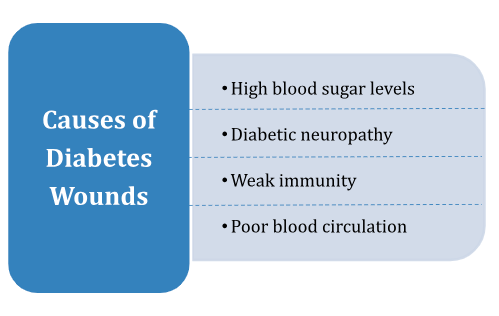
Diabetes comes with its own set of challenges. One such is diabetic wounds which are known to be difficult to heal. Around 11.8% of diabetes patients suffer from diabetic wounds. This data depicts how diabetes causes slow healing. So, in this blog, let us explore - the types of diabetic wounds, why they don’t heal easily, and treatment options for diabetic wounds.
Synopsis
Understanding Diabetic Wounds
Normally, our wounds start healing within a week, but we can’t say the same with diabetic wounds. Diabetic wounds have a delayed healing process and make you more susceptible to developing infections. These wounds often occur in areas where your senses are weakened or your blood flow is disrupted, especially at the bottom of your feet. Diabetic foot ulcers (DFUs) are the most common types of diabetic wounds. Patients with diabetes have a 25% higher likelihood of developing foot and chronic ulcers in their lifetime.
Types of Diabetic Wounds
Here are the different types of diabetic wounds:
Diabetic Foot Ulcers
Diabetic foot ulcers (DFUs) are the most common type of wound that diabetic patients experience. They are open sores that develop on the feet due to neuropathy, trauma, or excessive pressure. They typically appear on pressure points like the heels and balls or sides of the feet.
Affected Area: Feet and heels
Ischemic Ulcers
Inadequate blood flow to the feet due to peripheral artery disease (PAD) causes Ischemic wounds. It can be exacerbated by diabetes, causing tissue damage and non-healing ulcers. Poor circulation, delayed healing, and higher infection risk are all characteristics of Ischemic ulcers.
Affected Area: Toes and heels
Neuropathic Ulcers
Diabetes is also related to damaging the nerves, leading to a loss of protective sensation or neuropathy. It is called diabetic neuropathy. The inability to feel the pain in sudden injuries or abnormal pressures can cause calluses, corns, or blisters. Even minor cuts become ulcers and infections.
Nerve damage from diabetes may also deform foot joints and bones. This is called Charcot's foot. People with peripheral neuropathy are at a higher risk of developing this condition. Your inability to feel the pain and poor blood circulation may worsen the situation.
Affected Area: Feet
Infection-Related Wounds
With diabetes, your immunity gets compromised. So, if you are already wounded, there is a higher chance of it getting infected if not attended promptly.
Consult our diabetes and endocrinology hospital in Bangalore if you need diabetic wound treatment.
What Causes Diabetic Wounds to Heal Slower?
The possible causes of the slow healing of diabetic wounds include:

How to Speed Up the Healing Process of Diabetic Wounds?
Find your wounds and treat them immediately.
The faster you find a wound, the easier will it be to treat it. Here are the steps you can follow to treat them.
-
Wash the wounded area with warm water.
-
Stop the bleeding by putting pressure on the spot.
-
Apply a doctor-prescribed antibiotic cream to the wound.
-
Cover the wound with a bandage.
-
Check with your doctor if any medications are required for the wounds to heal.
NOTES:
-
Wash your hands with soap before touching the wound.
-
You must check for new wounds every day if you have neuropathy.
-
Do not put pressure on the wounded area.
Sometimes, the wounds may worsen over time. It may either reopen or get damaged. In such conditions, you must stop putting stress on or around the wound. This can be challenging if the wound is on your feet. There are specialized padded shoes you can opt for to avoid damage.
Maintain moisture around the wound
Previously, we have heard that keeping the wound open and letting the air pass helps it heal faster. However, that is not quite true. You must dress your wounded area properly and restore the moisture. Alternatively, you can also use hydrogel dressing to retain moisture.
However, if there is a constant discharge from the inside of your wound, you need to visit your doctor for a better dressing method. For example, Allevyn is more absorptive.
Preventing Diabetic Wounds
Below are some preventive methods to assist with diabetic wound care:
-
Monitor and maintain your blood sugar levels.
-
Go for regular health check-ups.
-
Practice proper foot hygiene.
-
Keep your feet clean and dry. Apply foot cream/body lotion to moisturize them.
-
Keep your toenails trimmed.
-
Wear soft socks that can help keep your feet dry.
-
Wear proper-fitting closed-toe shoes.
-
Avoid roaming barefoot. Keep your feet covered.
-
-
Quit smoking.
-
Stay aware of your medical history.
-
Lead an active life.
-
Eat healthy, especially more protein and vegetables.
-
If diabetic wounds are left untreated, it may result in diabetic foot ulcers. If you keep putting pressure on your feet, unaware of the wound, it leads to even more damage. This causes the skin to erode, causing ulcers.
Other than that, untreated diabetic wounds may even lead to:
-
Gangrene - kills the tissues surrounding the wound
-
Osteomyelitis - kills the bones
According to the data published by the National Institutes of Health, about 100,000 patients undergo foot amputations every year due to diabetes-related problems in India. This happens because of not staying vigilant about the wounds and how long they take to heal.
So, stay cautious and take all the precautions you can to avoid the adversities of diabetic wounds.
Consult our diabetes and endocrinology doctors in Bangalore if you need diabetic wound treatment.



















 5 Min Read
5 Min Read













